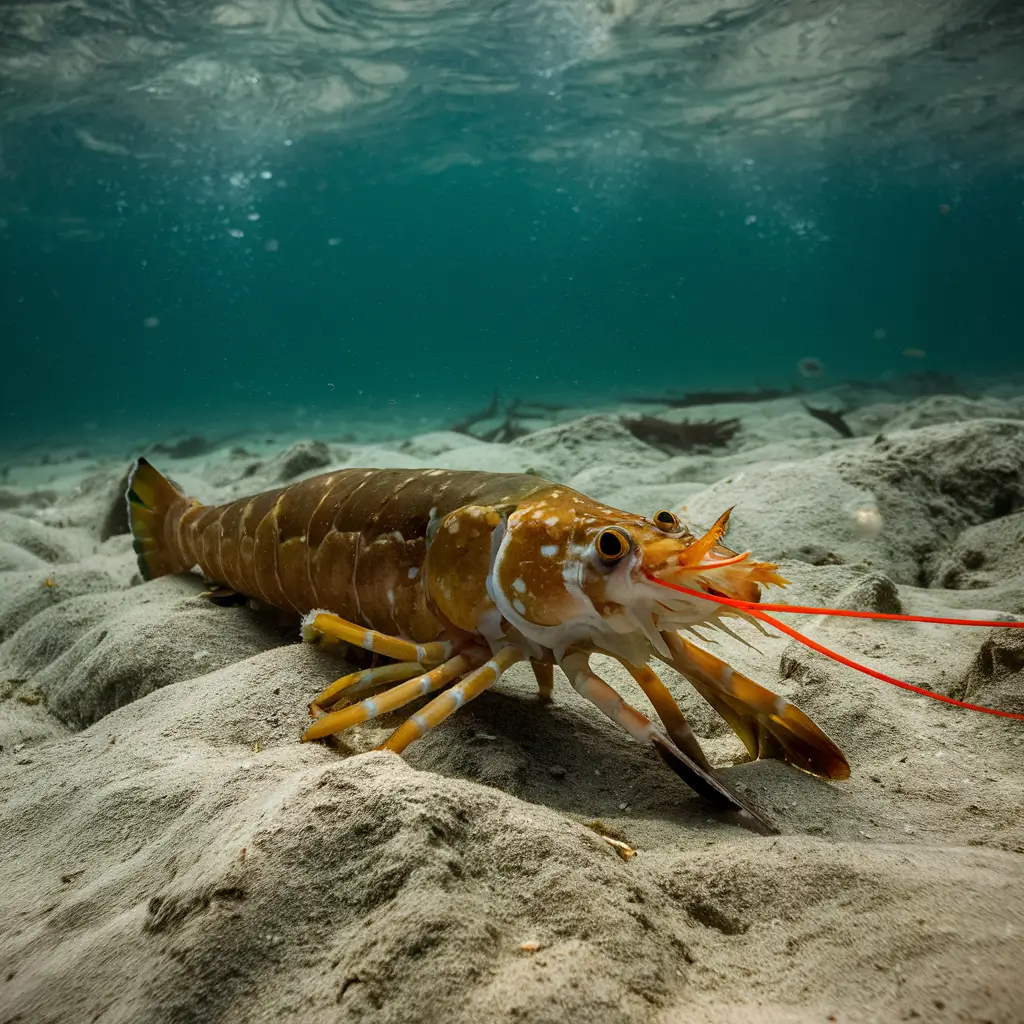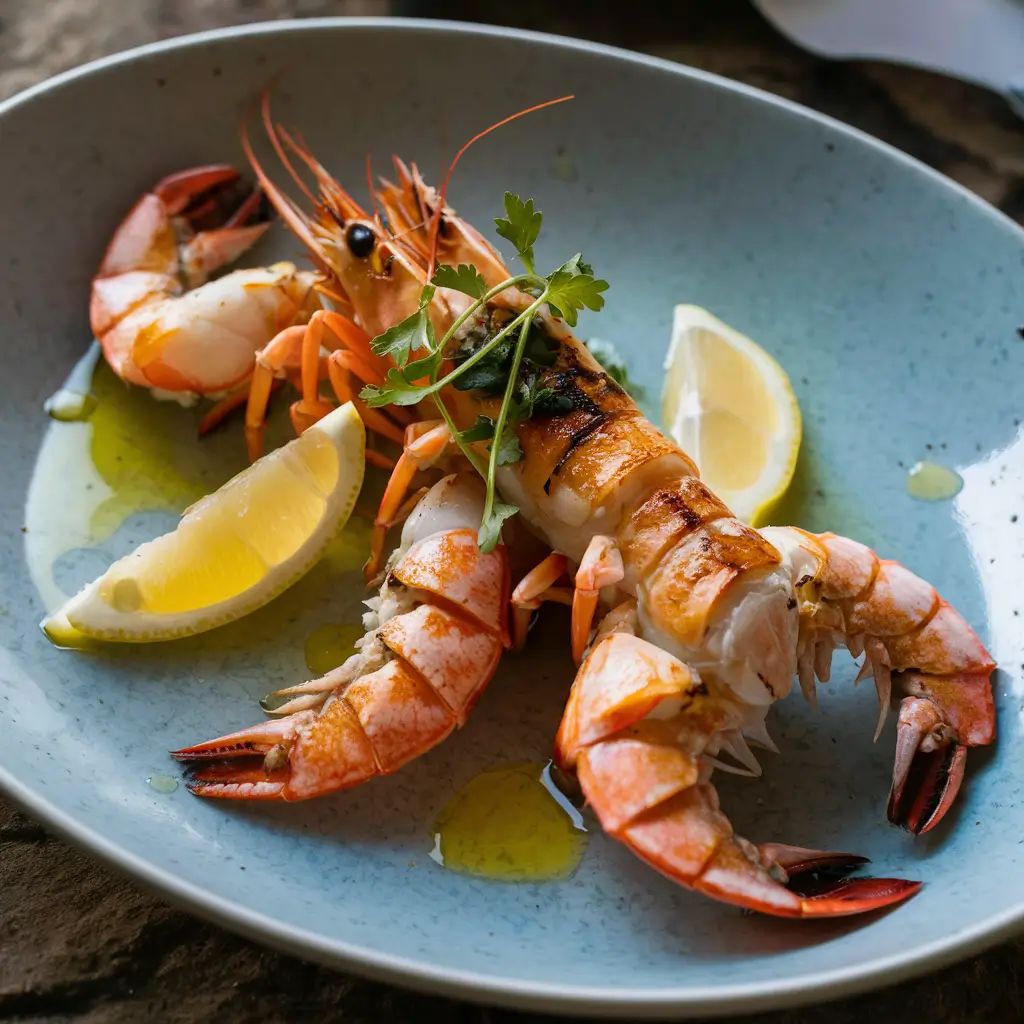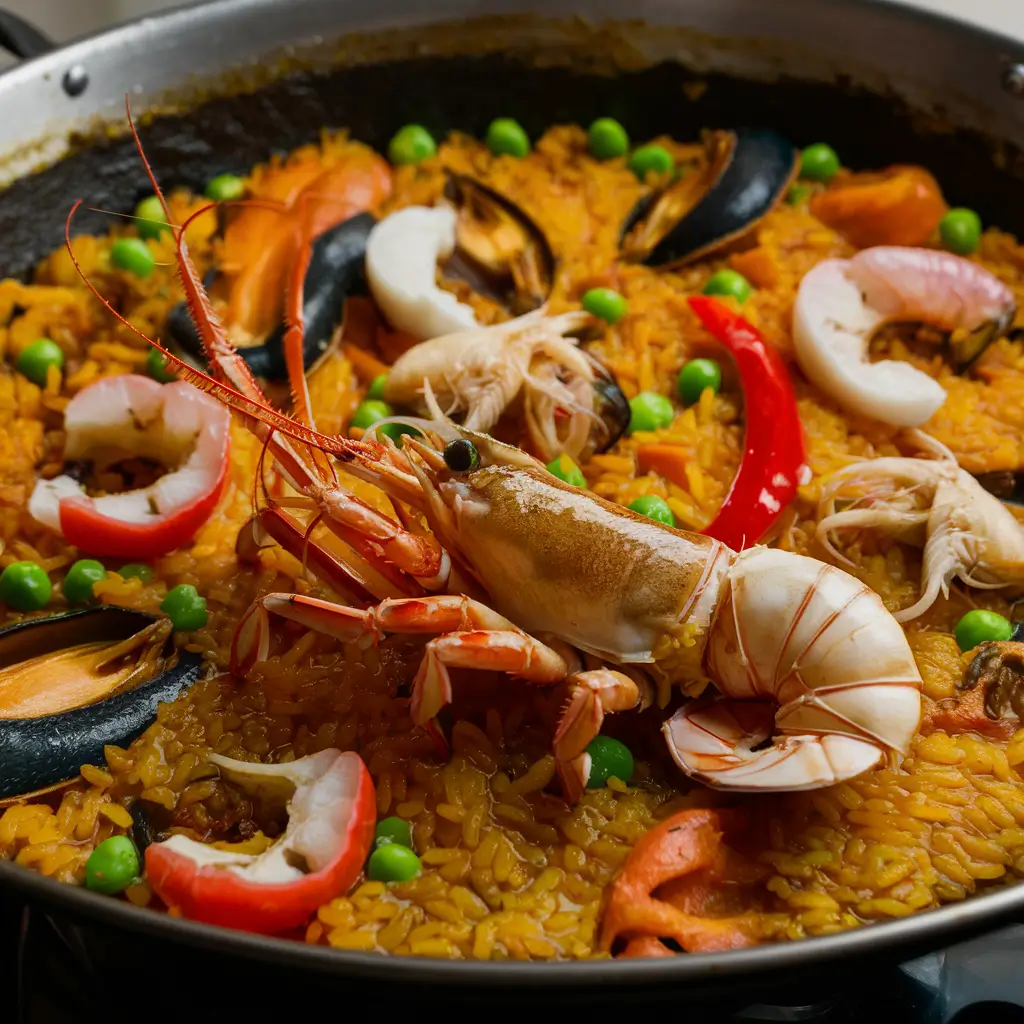Table of Contents
Langoustine, scientifically known as Nephrops norvegicus, is a remarkable type of shellfish that captivates seafood enthusiasts around the globe. This delicacy belongs to the family of crustaceans and is often likened to a smaller lobster, yet it possesses unique characteristics that set it apart. Typically ranging from 6 to 12 inches in length, they feature long, slender bodies adorned with a characteristic orange-pink hue, which can shimmer with iridescent qualities under the right lighting. Their elongated claws, reminiscent of those of a lobster, are also distinctive, although they are generally more delicate in comparison.

Langoustine are typically found in the cold waters of the North Atlantic, specifically along the coasts of Norway and Scotland. Unlike typical shrimp, they have a more complex flavor profile, often described as sweet and slightly nutty, making them a favored choice in gourmet cuisine. The sensory experience when consuming this seafood is further elevated by their tender, juicy meat, which is usually harvested and prepared in various culinary contexts, ranging from upscale restaurants to home dining.
In addition to their culinary appeal, langoustines are often sourced through sustainable fishing practices, ensuring that this delicacy can be enjoyed for generations to come. Their unique combination of flavor, texture, and visual appeal makes them an essential component of numerous dishes, from classic seafood platters to innovative modern gastronomy. As the appreciation for this exquisite shellfish continues to grow, understanding its distinguishing features and the seafood market’s role in its sustainability becomes increasingly important.
Origin and Habitat
Nephrops norvegicus primarily inhabits the North Atlantic Ocean, particularly along the continental shelf. It is commonly found in areas such as the coastal waters of Norway, Scotland, Ireland, and the eastern coastal regions of Canada and the United States. The geographical distribution of this species is influenced by various environmental factors, which are crucial for its growth and reproduction.
This delicacy thrives in cold waters, typically ranging from 6°C to 14°C (43°F to 57°F). It prefers sandy or muddy substrates found at depths of 30 to 800 meters, where they can burrow and create shelters that protect them from predators. Their preferred habitat contributes significantly to their ecological role, as they help maintain the health of the seabed ecosystems. The mixture of sand and mud serves not only as a substrate for burrowing but also provides a stable environment for their prey, which includes small fish and other invertebrates.
Fishing practices play a vital role in sustainability. The methods employed, such as creeling and trawling, vary by region and are regulated to prevent overfishing. Sustainable fishing initiatives aim to ensure that the population remains healthy and that the aquatic environment is preserved. For instance, certain areas implement size restrictions and seasonal closures to protect breeding stock during critical reproductive periods. These practices are imperative for maintaining the delicate balance of the marine ecosystem, wherein these creatures serve both as prey and predator.
In conclusion, understanding the origin and habitat of Nephrops norvegicus provides valuable insights into its ecological significance and sustainability. The delicate balance between fishing practices and environmental conditions continues to impact this sought-after delicacy of the sea.
Culinary Uses

Langoustine, often regarded as a luxurious seafood option, is cherished for its delicate flavor and tender texture. Its culinary uses span a wide range of preparations, showcasing its versatility in both traditional and contemporary culinary practices. One of the most popular methods of preparing langoustine is by boiling, often utilized in classic dishes like bouillabaisse, a traditional French fish stew. Here, langoustine contributes a distinct sweetness that complements the aromatic broth, enhancing the overall flavor profile of the dish. For another delicious seafood option, you might want to explore the incredible health benefits of tobiko
Grilling is another favored technique, which imparts a smoky char to the seafood, elevating its inherent flavors. In Mediterranean cuisine, grilled langoustines are typically served with a drizzle of olive oil and a squeeze of lemon, highlighting their freshness while maintaining simplicity. Additionally, sautéing is a method that can enhance the natural sweetness, frequently combined with garlic, herbs, and butter to create a harmonious dish, ideal for pairing with pasta or crusty bread.
Furthermore, they can be incorporated into sushi and sashimi, where their raw form is celebrated for its tender texture and clean taste. This preparation, prevalent in Japanese cuisine, exemplifies a creative approach to serving seafood. In modern gastronomy, chefs often showcase them in innovative presentations, such as carpaccio or tartare, which allow the ingredient to shine while incorporating elements of fine dining. Furthermore, their meat can be transformed into luxurious sauces, enriching dishes such as risotto or lobster bisque. Whether featured in a refined multi-course meal or enjoyed in a casual seafood platter, they remain a favored choice among culinary enthusiasts worldwide for their adaptability and exquisite flavor.
Nutritional Value
Langoustine, often referred to as the “little lobster,” is not only celebrated for its exquisite flavor but also for its impressive nutritional profile. This seafood delicacy is a rich source of protein, providing approximately 22 grams of protein per 100 grams serving. Protein is essential for muscle repair, immune function, and overall bodily maintenance, making langoustine an excellent choice for those looking to enhance their protein intake while enjoying a gourmet meal. To discover other seafood options with incredible health benefits, you might want to read about the health benefits of tobiko.
Furthermore, they are low in fat, typically containing only around 1 gram of fat per serving. This characteristic makes them an appealing option for health-conscious individuals who seek to maintain a balanced diet without compromising on taste. Importantly, the fat present in them is primarily unsaturated, contributing to heart health when consumed as part of a varied diet.
In terms of vitamins and minerals, they are an abundant source of essential nutrients. They provide significant amounts of vitamin B12, crucial for nerve function and the formation of red blood cells. Additionally, this seafood contains vitamin E, a powerful antioxidant that serves to protect the body from oxidative stress. Minerals such as zinc, selenium, and copper are also prevalent in langoustine, supporting various bodily functions including immune response, metabolism, and antioxidant defense mechanisms.
Moreover, incorporating this seafood into one’s diet can enhance nutritional diversity, particularly for those who prioritize seafood as a primary protein source. As a low-calorie option, it allows individuals to indulge in a gourmet experience while aligning with a healthy lifestyle. For culinary enthusiasts, their versatility in various recipes—from grilling to baking—enables one to enjoy its delightful taste while reaping the numerous health benefits it has to offer.
Tips for Cooking Langoustine
When it comes to preparing langoustine, selecting the freshest specimens is paramount. When purchasing them, look for those that have a firm shell and a pleasant, briny smell reminiscent of the sea. Avoid any that have a strong or off-putting odor, as this may indicate spoilage. If possible, it is recommended to buy from a reputable seafood market, where the product is guaranteed to be fresh.
Once you have selected your langoustines, proper storage is essential to maintain their quality. Store them in the coldest part of your refrigerator, usually at a temperature between 32°F and 36°F. It is best to keep them in a breathable container, such as a towel-lined bowl covered with a damp cloth, to allow for air circulation while preventing them from drying out. Ideally, consume them within 24 to 48 hours for the best flavor and texture.
Before cooking, cleaning your langoustines is an important step. Begin by rinsing the shellfish gently under cold running water to remove any sand or debris. To prepare them for cooking, use kitchen scissors to cut along the underside of the shell, from head to tail, to facilitate easier access to the meat. Be careful not to cut too deeply, as this might damage the delicate flesh inside.
After cleaning, you can opt to cook langoustines in a variety of ways, including boiling, grilling, or sautéing. For maximum flavor, consider seasoning with fresh herbs, garlic, and a hint of lemon. Cooking time should be kept short, as overcooking can lead to a tough texture. A general guideline is to cook them for just 3-5 minutes, until the meat turns opaque and tender. Following these tips will undoubtedly enhance your culinary experience with this exquisite shellfish.
Pairing Langoustine with Other Ingredients (Continued)
Sauces are another essential component when pairing with langoustine. A classic garlic butter sauce is a perennial favorite, providing richness and depth. Alternatively, citrus-based sauces, like a lemon beurre blanc or a tangy vinaigrette, can brighten the dish, adding a burst of acidity that complements the sweet meat of the langoustine beautifully. Moreover, Asian-inspired sauces, such as a soy-ginger glaze, can introduce an intriguing twist, creating a fusion that is sure to impress diners.
Ultimately, the versatility of langoustine allows for a wide range of culinary experimentation. By thoughtfully combining it with various ingredients, home cooks can create an impressive array of dishes that showcase this exquisite seafood in delightful new ways.
Sourcing Sustainable Langoustine
As consumers become more conscientious about their seafood choices, sourcing sustainable langoustine has gained considerable attention within the culinary community. The demand for this delicacy, known for its sweet, tender meat, necessitates a responsible approach to its harvesting. Sustainable fishing practices focus on minimizing environmental impact, thereby preserving fish stocks for future generations.
When looking for sustainable langoustine, it is essential to consider the fishing methods employed. Methods such as trap fishing, which minimizes bycatch and habitat disruption, are generally more sustainable than trawling. Additionally, consumers can seek out langoustine sourced from fisheries that adhere to strict environmental regulations, ensuring that their practices do not deplete fish populations or harm ecosystems. Organizations like the Marine Stewardship Council (MSC) provide certification that indicates a fishery is well-managed, allowing consumers to make informed choices about their seafood.
Moreover, responsible sourcing also involves understanding the origin of the langoustine. European langoustine, typically found in the North Atlantic, should be traced back to fisheries known for their commitment to sustainability. Certifications from recognized bodies signal that the seafood has been harvested in a manner that supports both marine health and community livelihoods.
As a consumer, being aware of the labels and certifications on packaging can significantly impact your seafood purchasing decisions. Support fisheries that practice sustainable harvesting methods, and look for reputable brands that prioritize ethical sourcing. By choosing sustainable langoustine, individuals not only enjoy a delectable meal but also contribute to the health of our oceans and the longevity of the seafood industry. This forward-thinking mentality can foster a greater appreciation for marine resources and pave the way for better practices in sourcing delectable sea delicacies.
Cultural Significance of Langoustine
Langoustine, known for its sweet and delicate taste, holds a prominent position in various culinary traditions around the world. Particularly celebrated in Mediterranean cuisine, this exquisite shellfish emerges as a centerpiece in numerous traditional dishes. Countries like Spain, France, and Italy showcase langoustine in their gastronomy, highlighting its cultural value and significance in their local culinary practices.

In Spain, for instance, langoustine is often featured in dishes such as paella, a celebrated rice dish that illustrates the rich tapestry of Spanish cuisine. The incorporation of langoustine not only adds a luxurious touch but also exemplifies the region’s sea-to-table movement, ensuring freshness and sustainability. Additionally, seafood festivals along the Spanish coast further celebrate this delicacy, drawing locals and tourists alike to partake in the culinary festivities centered around langoustine.
France offers its own unique homage to langoustine, particularly in the Brittany region. Here, culinary artisans create a variety of gourmet preparations that elevate the shellfish, from elegant bisques to simple grilled dishes. The appreciation for langoustine in French cuisine is often reflected in fine dining establishments, where chefs meticulously honor its natural flavors. Langoustine also finds its way into traditional French holiday feasts, emphasizing its role as a luxury ingredient in celebratory meals.
In Italy, langoustine is appreciated both in rustic dishes and elaborate gourmet fare. The ingredient’s versatility allows it to shine in pasta dishes, seafood broths, and even on pizza, illustrating its integration across different culinary expressions. Various regions hold festivals to celebrate the harvest of langoustine, enhancing its cultural relevance in Italian life and cuisine.
Ultimately, langoustine symbolizes more than just a culinary delight; it represents a shared cultural heritage across many regions, showcasing local traditions, seasonal celebrations, and a respect for the sea’s bounty. Each cultural interpretation adds to the tapestry of global gastronomy, enriching the appreciation for this gourmet shellfish.
Conclusion
In conclusion, langoustine stands out as a remarkable seafood delicacy, revered for its sweet, tender meat and unique flavor profile. This crustacean, often referred to as “Norway lobster,” not only enhances gourmet dishes but also invites culinary exploration within home kitchens. The versatility of langoustine makes it an ideal ingredient for a variety of culinary traditions, whether incorporated into luxurious pasta dishes, elegant seafood risottos, or simply grilled to highlight its natural flavor. The distinct taste it contributes to various recipes underscores its desirability among chefs and home cooks alike.
Throughout this article, we have highlighted key aspects of langoustine, including its sustainability, nutritional benefits, and preparation techniques. This knowledge allows enthusiasts to appreciate not only how to cook with langoustine but also the broader context of its ecological impact and the importance of choosing responsibly sourced seafood. By integrating this exquisite ingredient into your meals, you elevate the dining experience and indulge your palate in something truly exceptional.
We invite you to explore delicious recipes featuring langoustine and step out of your culinary comfort zone. Experimenting with this delicacy can lead to delightful surprises in taste and texture, invigorating your cooking repertoire. Whether you are a seasoned chef or a home cook seeking to expand your skills, langoustine offers an exciting opportunity to embrace the richness of the sea in your culinary creations. Delight in the journey of cooking with langoustine, and let your taste buds celebrate this extraordinary seafood delight.

